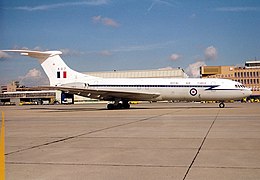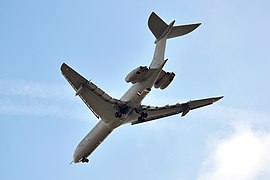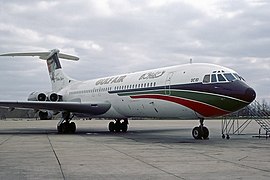Vickers VC10
| Vickers VC10 | |
|---|---|
 VC10 of the airline BOAC |
|
| Type: | Four - engined narrow-body aircraft |
| Design country: | |
| Manufacturer: | |
| First flight: |
June 29, 1962 |
| Commissioning: |
April 29, 1964 |
| Production time: |
1962 to 1970 |
| Number of pieces: |
54 |
The Vickers VC10 the British Aircraft Corporation (BAC) was one of the first jet-propelled civilian long-range aircraft . Construction of the type began at Vickers-Armstrongs (Aircraft) Ltd. in the late 1950s . Part of the civilian fleet was later converted into tanker aircraft, six of which were still in service with the Royal Air Force (RAF) in early 2013 . The last flight of a VC10 of the RAF took place on September 25, 2013 - and thus also the last flight of a VC10 at all.
history
development
In 1956, Vickers-Armstrongs received an order from the airline BOAC to develop a long-haul jet-propelled aircraft. This should especially meet the requirements on the routes from London to South Africa and Australia . The design of the VC10 differed significantly from the concept used in the first British jet-propelled airliner, the De Havilland "Comet" . Experience had shown that the wing construction with the engines integrated in the wing was very prone to failure. Therefore it was decided to mount the four engines at the stern. The construction was based in part on the military transporter draft V-1000 for the RAF from 1952 and its civilian offshoot VC7 . The original version, the prototype of which first flew on June 29, 1962, was designed for 135 passengers. Vickers-Armstrongs received an extended order for 55 machines on January 14, 1958 (35 orders + 20 options). The increasing competition from the Boeing 707 and DC-8 became a problem, however, as they appeared cheaper to maintain. After the construction of the Super 200 , which was 8.12 m longer and equipped with more powerful engines, the designers then presented a new, elongated version (but only 3.9 m longer than the original VC10) that could carry up to 212 passengers. This version was called the Super VC10 . In the Soviet Union, the conceptually very similar Ilyushin Il-62 was built. In 1960 the aircraft manufacturing of Vickers-Armstrongs, Bristol , English Electric and Hunting Aircraft was combined in the British Aircraft Corporation (BAC). In May 1961 BOAC ordered 15 VC10 and 35 Super VC10 (some of them in freight configuration similar to the C1) from BAC, but later changed and shortened the order several times, whereupon the RAF stepped in as a buyer.
Use as a passenger aircraft
On April 1, 1965 BOAC began regular service with the VC10 on the London - New York route . The interior was designed by the famous British designer couple Robin and Lucienne Day . At this point in time, the airline was already increasingly interested in the Boeing 707, as it was more powerful. Government pressure to buy a UK-made aircraft ultimately led the state-owned BOAC to purchase additional VC10s. In order to operate as economically as possible, BOAC mainly used the Super VC10 with its higher seating capacity on transatlanktic routes, while the "standard version" with its higher performance due to its lower weight was mainly used on routes to the Middle East .
Other buyers were mainly airlines in Africa and Asia , as the aircraft was significantly more reliable than the competing models, especially at higher temperatures. Ultimately, however, the VC10 and the Super VC10 were not a commercial success. A total of only 54 machines were built. British Airways , the successor to BOAC, retired its last VC10 in 1981. By the end of the 1980s, the rest of the civil aircraft in Africa and Asia were also retired.
Military use
VC10 C1, passenger version of the Royal Air Force at Stuttgart Airport
Royal Air Force VC10 over Iraq in January 2005
While the VC10 failed in the civil aviation market, it had greater success in the military field. As early as 1961, the British Royal Air Force ordered five VC10 transport aircraft. At the time, they were the most powerful and largest aircraft in the RAF. The delivery of 14 newly built VC10 C1s to the No.10 Squadron in Brize Norton began in 1966 and the machines were already in use from April of the following year (on long-distance transports to Hong Kong). In total, the fleet later grew to 28 machines by 1996 through the purchase of used civil aircraft; the latter was awarded the No. 101 Squadron set up another squadron. The transporters were also regular visitors to the RAF Germany military airfields .
In 1978 the Royal Air Force commissioned the armaments company British Aerospace to convert the VC10 and Super VC10 into tanker aircraft . During the Falklands War of 1982, a converted VC10 carried out air refueling for the first time . Since then, the aircraft - supplemented by nine Lockheed L-1011 TriStar since 1986 - have been in service worldwide both as tanker and transport aircraft. In April 1987, an RAF VC10 set a new world record on the London - Sydney route with 16 hours, one minute and 30 seconds . Based on the abbreviation VC , each of the machines bears the name of a bearer of the Victoria Cross , the highest military honor in the United Kingdom.
However, due to their old age and rising maintenance and repair costs, the VC10 should be retired by 2010. The Airbus A330 was selected as the successor model . Since the late 1990s, the fleet has been reduced by 12 machines to 16, with a VC10 destroyed on the ground in a refueling accident. In 2005 all remaining machines of the No. Subordinated to 101 Squadron ; one aircraft was permanently stationed at the RAF Mount Pleasant airfield in the Falkland Islands and the No. 1312 flight assigned.
In January 2007 it became known that the remaining machines would be used five years longer than planned until 2015 and should be modernized again for this purpose. The reason for this was delays in the acquisition of the Future Strategic Tanker Aircraft . The white paper published in October 2010 called for the type to be phased out by May 2013. In the meantime, even March 2013 was planned, but after that the remaining machines should continue to be operated until September 2013. In the remaining time, the VC10 should normally only be used as a tanker; the transport tasks should be transferred to the TriStar fleet.
From April to November 2011 three tankers were stationed in support of NATO in the Libya crisis at Trapani airport in Sicily and at the RAF Akrotiri base in Cyprus.
Since 2001 the VC10 fleet has been continuously reduced, the machines no longer needed were transferred from RAF Brize Norton to RAF St Athan and RAF Bruntingthorpe for scrapping. In November and December 2011 this affected three aircraft ("T", "X" and "S"), so that in February 2012 nine of the original 28 VC10s were still in service with the Royal Air Force:
The RAF carried out the last official training flights on September 20, 2013. The last flights of the two machines took place at the end of September 2013. ZA150 was transferred to Dunsfold Airfield on September 24, 2013 to be preserved in the museum on the former Brooklands Airfield . The last VC10 of the RAF with the registration number ZA147 was flown to Bruntingthorpe on September 25, 2013, where there is also an aviation museum.
Versions
Civilian use
East African Airways Super VC10 , 1974
Gulf Air VC-10 , 1977
British United Airways VC-10 , 1969
(40 copies, 14 of them in military use):
- Vickers VC10 version 1100 : prototype, one copy (later converted to version 1109)
- BAC VC10 version 1101 : BOAC standard, a total of 35 pieces ordered, 12 built
- BAC Standard VC10 Version 1102 : Ghana Airways standard station wagons , three built (one machine converted to version 1103)
- BAC Standard VC10 Version 1103 : British United Airways (BUA) standard station wagons, two built (one machine converted to 1102)
- BAC Standard VC10 Version 1104 : Nigeria Airways Standards, two ordered, none built
- BAC Standard VC10 Version 1109 : Conversion of Version 1100 for rental to Laker Airways
- BAC Super VC10 Version 1150 : Further development of the model 1100 to the Super VC10
- BAC Super VC10 Version 1151 : BOAC Super, 22 ordered at different times, 17 built
- BAC Super VC10 Version 1152 : BOAC Super-Kombi, 13 ordered, none built
- BAC Super VC10 Version 1154 : East African Airways "Super-Kombi", five built
Military operation
(14 new and 14 rebuilt copies):
- VC10 C1 (RAF designation of version 1106 ): Military transport version for 150 people or 76 stretchers with side cargo door (3.55 m × 2.13 m), Turbomeca Artouste auxiliary gas turbine in the rear, air refueling probe and reinforced cabin floor, first flight November 26, 1965 , 14 built , 13 converted to VC10 C1K, K2 and K3
- VC10 C1K (RAF designation of version 1180 ): 13 aircraft of the military version 1106 converted to transport / tanker aircraft with hose containers under the wings, total fuel 88 t, up to 20 t payload
- VC10 K2 (RAF designation of version 1112 ): five aircraft of the civilian version 1101, which were converted into tankers, with three hose systems, additional tanks and only 17 seats in the cabin, first flight June 22, 1982, total fuel 97.7 t
- VC10 K3 (RAF designation of version 1164 ): four copies converted from the civilian version 1154 to tankers, first flight July 4, 1984, total fuel 97.7 t
- VC10 K4 (RAF designation for version 1170 ): five aircraft of the civilian version 1151, which were converted into tankers, with three hose systems, but without additional tanks in the cabin, first flight July 30, 1993, total fuel 85.2 t
Military users
Incidents
Between the first flight in 1962 and the end of 2013, seven VC10s were lost in accidents or acts of war. Two of them resulted in a total of 130 deaths. Full list:
- On December 28, 1968, a Ghana Airways VC10 ( aircraft registration number 9G-ABP ) was destroyed along with 13 other aircraft in an Israeli ground attack at Beirut airport . The aircraft was leased to Middle East Airlines .
- On November 20, 1969, a Nigeria Airways (5N-ABD) VC10 brushed several trees when approaching about 13 kilometers from Lagos Airport due to an insufficient flight altitude and fell, killing all 87 occupants.
- On September 8, 1970, Palestinian terrorists hijacked a VC10 of the BOAC ( G-ASGN ) in the Jordanian desert to the abandoned former air base Zarqa ( Dawson's Field ) of the Royal Air Force. There it was blown up four days later, along with two other hijacked aircraft, after all passengers had left the aircraft.
- On January 28, 1972, a British Caledonian Airways ( G-ARTA ) VC10 was so badly damaged in a failed landing in London-Gatwick that it had to be scrapped.

- On April 18, 1972 burst a tire a starting VC10 of East African Airways (5X-UVA) on the Addis Ababa after he had rolled over one lying on the runway steel part. The part belonged to a Cessna 185 that had started five hours earlier . Due to an incorrectly repaired brake system, the machine did not come to a stop in time after the start abort was initiated and shot over the runway. Of the 107 occupants, 43 were killed in the accident.
- On March 3, 1974, a hijacked BOAC ( G-ASGO ) VC10 was set on fire and destroyed by the hijackers at Schiphol Airport . People were not harmed.
- On December 18, 1997, a Royal Air Force VC10 ( XR806 ) was so badly damaged in a refueling accident at Brize Norton Air Force Base that it was later scrapped. It is assumed that the staff forgot to empty the tank in the rear first, so that the machine reared up due to the incorrect weight distribution and hit the apron with the rear area.
Technical specifications
| Parameter | Data of the VC10 | Data of the Super VC10 |
|---|---|---|
| length | 48.36 m (C1K 50.6 m) | 52.32 m (K3 / K4 54.6 m) |
| span | 44.55 m | |
| height | 12.04 m | |
| Gauge | 6.53 m | |
| wheelbase | 20.08 m | 20.08 m (K3 / K4 21.98 m) |
| Cabin length | 28.18 m | 28.18 m (K3 / K4 32.00 m) |
| Max. Cabin width | 3.50 m | |
| Max. Cabin height | 2.26 m | |
| Empty mass | 63.28 t (C1K 66.22 t) | 70 t (K3 70.2 t, K4 71.94 t) |
| Max. Takeoff mass | 141 t (C1K 146 t) | 153 t (K3 / K4 151.5 t) |
| Max. Landing mass | 106.6 t | |
| Range | 9,765 km (6,275 km C1 with full payload) | 11,470 km |
| Top speed | 915 km / h | 933 km / h |
| Cruising speed | 885 km / h | |
| Stall speed | 182 km / h | |
| Service ceiling | 11,580 m | |
| Takeoff route | 2530 m | |
| Landing route | 2135 m | |
| Passengers | 135 | 176 |
| Engines | 4 × Conway 42 Mk301 , each 97.8 kN | 4 × Conway 43 Mk550B, 100.1 kN each |
| number | 32 planes | 22 planes |
Preserved copies in museums
There is one VC10 each in Duxford , in the Royal Air Force Museum Cosford, Shropshire (XR808), at Dunsfold Airport (to come to Brooklands) and at Newquay Airport , two each at their place of origin in Brooklands and in Bruntingthorpe . A ninth VC10 can be viewed in Hermeskeil .
See also
- Types with comparable role, configuration and era
Web links
- vc10.net , a frequently updated English VC10 fan site, accessed on January 11, 2017
- Detailed overview of the VC10s currently in use at the RAF at vc10.net, accessed on January 11, 2017
- defenseindustrydaily.com , information on converting the VC10s by 2012, in English, accessed on January 11, 2017
Individual evidence
- ^ Message from flightglobal.com (news) and in the print edition Flight International, January 29 to February 4, 2013, p. 17
- ↑ a b Craig Hoyle: VC10 retirement speeds RAF airlift transition. Flightglobal.com, September 24, 2013, accessed January 11, 2017 .
- ↑ a b Jelle Hieminga: History - BOAC and the VC10. In: vc10.net. Retrieved March 2, 2019 .
- ^ Securing Britain in an Age of Uncertainty: The Strategic Defense and Security Review. (PDF; 820 kB) In: Cabinet Office. HM Government, October 2010, pp. 25-27 , archived from the original on October 15, 2012 ; accessed on January 11, 2017 (English): “It will replace the aging TriStar and VC10 fleets; the first aircraft is due to be delivered towards the end of 2011; [...] reduce the role of the VC10 transport / tanker aircraft to undertake air-to-air refueling only, with the target of withdrawing it by 2013 as A330 enters service; "
- ^ VC10 Fleet Reductions . In: Air International . Key Publishing, Stamford February 2012, p. 8 (English).
- ↑ VC10s in RAF service. In: vc10.net. Retrieved January 11, 2017 .
- ↑ BBC News, accessed September 20, 2013
- ↑ FlugRevue February 2009, pp. 51–54, aircraft down to the smallest detail - Vickers VC10 tanker / transporter
- ↑ Accident Statistics VC10 , Aviation Safety Network (English), accessed on January 11, 2017.
- ^ Accident report VC10 9G-ABP , Aviation Safety Network (English), accessed on January 11, 2017.
- ^ Accident report VC10 5N-ABD , Aviation Safety Network (English), accessed on January 11, 2017.
- ^ Hijacking of a Swissair DC-8 to Zerqa in: NZZ Online from September 5, 2005, accessed on January 11, 2017
- ↑ accident report VC10 G ASGN , Aviation Safety Network (English), accessed on 11 January 2017th
- ^ Accident report VC10 G-ARTA , Aviation Safety Network (English), accessed on January 11, 2017,
- ^ Accident report VC10 5X-UVA , Aviation Safety Network (English), accessed on January 11, 2017.
- ↑ ICAO Aircraft Accident Digest No. 21, Circular 132-AN / 93 (English), pp. 3–21.
- ↑ accident report VC10 G-ASGO , Aviation Safety Network (English), accessed on 11 January 2017th
- ↑ accident report VC10 XR806 , Aviation Safety Network (English), accessed on 11 January 2017th
- ↑ Jelle Hieminga: Incidents and Accidents. In: vc10.net. Retrieved March 2, 2019 .










